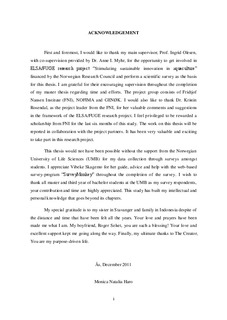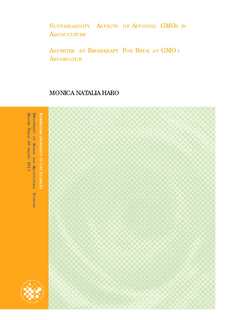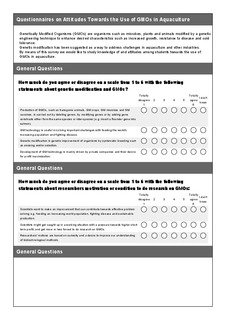| dc.contributor.author | Haro, Monica Natalia | |
| dc.date.accessioned | 2012-05-18T12:35:35Z | |
| dc.date.available | 2012-05-18T12:35:35Z | |
| dc.date.issued | 2012-05-18 | |
| dc.identifier.uri | http://hdl.handle.net/11250/186151 | |
| dc.description.abstract | Genetic modification technology has been suggested as a way to address challenges in aquaculture and other industries. For instance, the demand for fishmeal and fish oil in aquaculture industry is expected to increase rapidly, potentially resulting in increased prices. Salmon feed represents the majority expense (approximately 60-70%) of the total production costs. Genetically modified plants may be one option to replace the use of marine feed ingredients and at the same time reduce the expenses. By GMO technology it may also be possible to develop genetically modified fish, also called transgenic fish, to enhance desired characteristics such as increased growth, resistance to disease and cold tolerance. The first objective of this thesis is to identify UMB students’ knowledge, attitudes and degree of support towards genetic modification (GM) and the use of GMOs in aquaculture. The second is to explore whether the use of GM plants as ingredients in farmed salmon feed are acceptable as alternative feed resources, and if it is considered important among respondents to label the salmon as a GMO if the salmon has been fed with GM plant feed. Finding whether GM, Marker-assisted selection (MAS) and traditional selection are considered as acceptable methods to improve growth and/or disease resistance of farmed salmon is the third objective. A questionnaire was designed to gather response regarding these matters.
Genmodifisering er en teknologi som kan møte dagens utfordringer innen akvakultur og annen industri. Eksempelvis er behovet for fiskemel og fiskeolje innen fiskeoppdrettsindustrien ventet å øke raskt, noe som kan medføre stigende priser. Laksefôr representerer i dag innen akvakultur næringen i Norge over halvparten (ca. 60-70%) av de totale produksjonskostnadene. Genmodifiserte (GM) planter kan være en mulighet til å erstatte bruken av marine fôringredienser i tillegg til å redusere kostnadene. Ved hjelp av genmodifisering er det også mulig å utvikle GM fisk, også kalt transgen fisk, med forbedrede egenskaper som økt tilvekst, sykdomsresistens og toleranse for lave temperaturer. Målsettingen med denne oppgaven er for det første å studere kunnskap, holdninger og støtte til genmodifisering og bruken av GMO i akvakultur blant studenter ved Universitetet for Miljø- og Biovitenskap (UMB). Videre å finne ut om bruken av GM planter er aktuelt som en alternativ fôr-ingrediens, og om det i så fall innebærer at laksen som har spist GM planter må merkes som GMO. Den tredje målsettingen er å finne ut om genmodifisering, markørassistert seleksjon (MAS) og tradisjonell seleksjon er vurdert som akseptable metoder for å forbedre vekst og/eller sykdomsmotstand hos oppdrettslaks. En spørreundersøkelse ble gjennomført for å samle inn data om disse temaene. | no_NO |
| dc.description.sponsorship | ELSA/FUGE research project “Stimulating sustainable innovation in aquaculture”, financed by the Norwegian Research Council. | no_NO |
| dc.language.iso | eng | no_NO |
| dc.publisher | Norwegian University of Life Sciences, Ås | |
| dc.subject | ethics | no_NO |
| dc.subject | technology | no_NO |
| dc.subject | genetically modified organisms | no_NO |
| dc.subject | survey | no_NO |
| dc.subject | transgenic salmon | no_NO |
| dc.subject | GM feed | no_NO |
| dc.subject | GMO | no_NO |
| dc.subject | MAS | no_NO |
| dc.subject | genmodifisering | no_NO |
| dc.subject | fiskeoppdrett | no_NO |
| dc.subject | transgen fisk | no_NO |
| dc.title | Sustainability aspects of applying GMOs in aquaculture | no_NO |
| dc.title.alternative | Aspekter av bærekraft for bruk av GMO i akvakultur | no_NO |
| dc.type | Master thesis | no_NO |
| dc.subject.nsi | VDP::Agriculture and fishery disciplines: 900::Fisheries science: 920::Aquaculture: 922 | no_NO |
| dc.source.pagenumber | 84 | no_NO |


